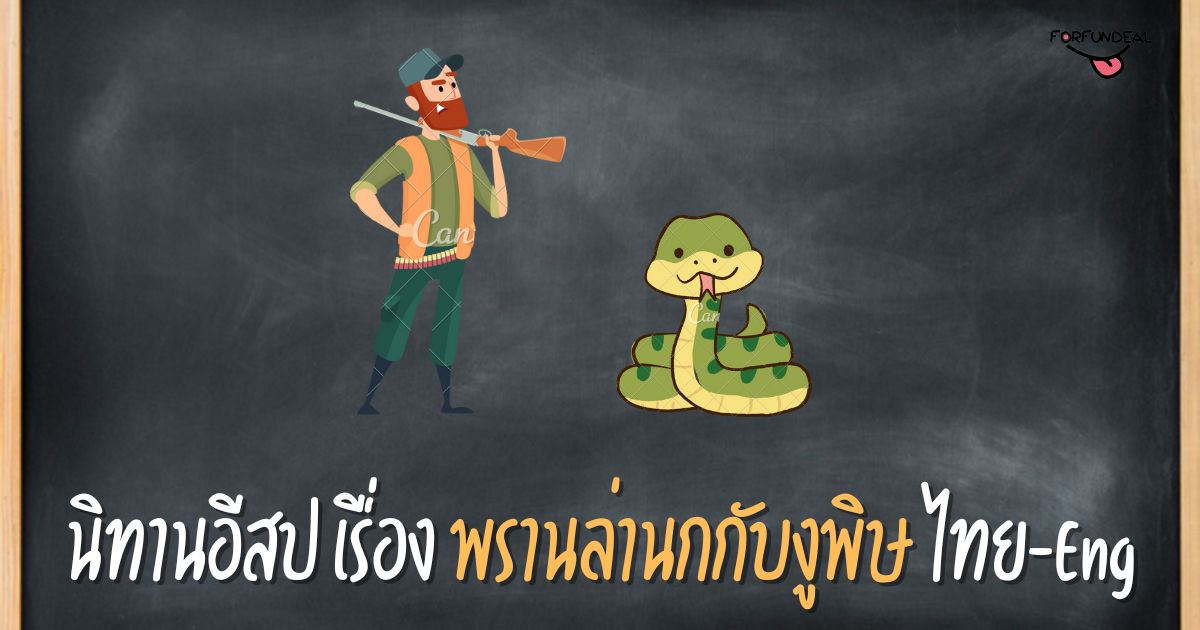“พรานล่านกกับงูพิษ” เป็นนิทานอีสปที่สอนเราถึงผลของการกระทำของเรา เมื่อผู้คนวางแผนไม่ดีกับคนอื่น พวกเขาตกเป็นเหยื่อของแผนการแบบเดียวกันนั่นเอง
นิทานอีสปเรื่องพรานล่านกกับงูพิษ
กาลครั้งหนึ่งนานมาแล้ว ในหมู่บ้านอันเงียบสงบที่ตั้งอยู่ท่ามกลางทุ่งหญ้าเขียวขจี มีพรานล่านกฝีมือดีอุทิศเวลาวันเวลาของเขาเพื่อประดิษฐ์บ่วงนกที่สลับซับซ้อน เขาเตรียมกับดักเหล่านี้อย่างพิถีพิถัน ภารกิจของเขาคือการจับนกที่เป็นเหยื่อ ที่ข้ามขอบเขจของเขามา ด้วยการมุ่งความสนใจไปที่งานฝีมือเพียงอย่างเดียว เขาจึงยังคงเพิกเฉยต่อโลกรอบตัวเขา
Once upon a time, In a peaceful village nestled amidst lush fields, a skilled fowler dedicated his days to crafting intricate bird-snares. He meticulously prepared these traps, consumed by his mission to capture the unsuspecting birds that crossed his path. With his focus solely on his craft, he remained oblivious to the world around him.
วันแห่งโชคชะตาวันหนึ่ง พรานป่าเผลอไปเหยียบงูที่ซ่อนตัวอยู่โดยบังเอิญ งูตกใจและเจ็บตอบสนองด้วยการกัดและพ่นพิษ พรานล่านกตั้งตัวไม่ทัน ไม่มีการป้องกันการโจมตีอันว่องไวของงู พิษไหลเวียนผ่านเส้นเลือดของเขา และเขาก็ล้มลงกับพื้น
One fateful day, consumed by his task, the fowler accidentally trod upon a concealed snake. Startled and provoked, the snake reacted by delivering a venomous bite. The fowler, caught off guard, had no defense against the snake’s swift strike. The poison coursed through his veins, and he crumpled to the ground.
ข่าวชะตากรรมอันน่าสลดใจของพรานล่านกแพร่สะพัดไปทั่วหมู่บ้าน และเสียงประชดประชันก็ลอยอยู่ในอากาศ ชายผู้ทุ่มเทแรงกายแรงใจเพื่อดักจับนกที่ไร้เดียงสายังคงไม่รู้ว่าการไล่ล่าของเขาเองนั้นติดกับดักมรณะที่เขาสร้างขึ้นเอง การกัดของงูตอกย้ำความจริงอันโหดร้ายว่าอุบายที่เขาคิดขึ้นมาเพื่อดักจับคนอื่นกลับทำให้เขาติดกับดักแทน
News of the fowler’s tragic fate spread throughout the village, and a poignant irony hung in the air. The man who dedicated his energy to ensnaring innocent birds remained ignorant that his own pursuit had entangled him in a deadly trap of his own making. The snake’s bite underscored the harsh reality that the very schemes he devised to ensnare others had ensnared him instead.
ชาวบ้านครุ่นคิดถึงบทเรียนที่ฝังอยู่ในเหตุการณ์ที่โชคร้ายนี้ พวกเขาตระหนักถึงความจริงเหนือกาลเวลาที่ว่าผู้ที่วางแผนทำร้ายผู้อื่นมักตกเป็นเหยื่อของกับดักที่พวกเขาวางไว้เอง นิทานเรื่องนี้กลายเป็นเครื่องเตือนใจว่าการกระทำที่เกิดจากความอาฆาตพยาบาทสามารถย้อนกลับมาทำร้ายผู้กระทำได้
The villagers contemplated the lesson embedded in this unfortunate event. They recognized the timeless truth that those who hatch plots against their neighbors often fall victim to the very traps they set. The tale became a sobering reminder that actions fueled by malice can boomerang back to afflict the doer.

นิทานเรื่องนี้สอนให้รู้ว่า
“ผู้ที่วางแผนต่อต้านผู้อื่นอาจพบว่าตนเองติดกับดักในการกระทำของตนเองเสมอ”
- เสียงสะท้อนของการกระทำ: การเล่าเรื่องสะท้อนสุภาษิตโบราณที่ว่า “เก็บเกี่ยวสิ่งที่คุณหว่าน” ชะตากรรมของนายพรานล่านกเป็นเครื่องเตือนใจว่าการกระทำที่มุ่งร้ายอาจนำไปสู่ผลลัพธ์ที่คาดไม่ถึง
- การลงโทษโดยไม่ตั้งใจ: โศกนาฏกรรมของนายพรานล่านกเป็นตัวอย่างของแนวคิดที่ว่าการกระทำเชิงลบที่มุ่งเป้าไปที่ผู้อื่นสามารถย้อนกลับมาได้โดยไม่คาดคิด แสดงให้เห็นถึงความสำคัญของการปฏิบัติต่อผู้อื่นด้วยความซื่อสัตย์และความเห็นอกเห็นใจ
- สะท้อนความตั้งใจ: เรื่องราวกระตุ้นให้เราไตร่ตรองถึงแรงจูงใจของเราก่อนที่จะแสดง มันกระตุ้นให้เราพิจารณาว่าความตั้งใจของเรานั้นยุติธรรมจริงๆ หรือไม่ และการกระทำของเราอาจนำไปสู่อันตรายที่ไม่ได้ตั้งใจหรือไม่
- ความรับผิดชอบทางศีลธรรม: เรื่องนี้ตอกย้ำแนวคิดเรื่องความรับผิดชอบทางศีลธรรม ผู้ที่วางแผนทำร้ายผู้อื่นอาจต้องรับผิดชอบต่อการกระทำของพวกเขาในท้ายที่สุด ซึ่งแสดงให้เห็นถึงความจำเป็นในการพิจารณานัยทางจริยธรรมของการเลือกของเรา
- มุมมองจากธรรมชาติ: ปฏิกิริยาของงูต่อการถูกคุกคามสะท้อนถึงผลที่ตามมาของการกระทำที่ขับเคลื่อนด้วยความเกลียดชัง ธรรมชาติมักจะให้อุปมาอุปไมยที่มีค่าสำหรับบทเรียนของชีวิต กระตุ้นให้เราปรับตัวให้เข้ากับผลลัพธ์ของปฏิสัมพันธ์ของเรามากขึ้น
- ความเมตตาและการเอาใจใส่: แทนที่จะวางแผนต่อต้านผู้อื่น เรื่องราวเน้นให้เห็นถึงคุณค่าของความเมตตาและการเอาใจใส่ การปฏิบัติต่อผู้อื่นด้วยความเห็นอกเห็นใจและความเคารพสามารถนำไปสู่ผลลัพธ์ที่เป็นบวกมากขึ้นสำหรับทุกคนที่เกี่ยวข้อง
“Those who scheme against others may find themselves ensnared by their own actions.”
- Echoes of Actions: The narrative echoes the age-old adage of “reaping what you sow.” The fowler’s fate serves as a poignant reminder that actions driven by malicious intent can lead to unforeseen consequences.
- Unintended Retribution: The fowler’s tragedy exemplifies the idea that negative actions aimed at others can unexpectedly boomerang back, demonstrating the importance of treating others with integrity and empathy.
- Reflecting on Intentions: The story encourages us to reflect on our motives before acting. It prompts us to contemplate whether our intentions are genuinely just and whether our actions could lead to unintended harm.
- Moral Responsibility: The tale underscores the concept of moral responsibility. Those who scheme to harm others may ultimately be held accountable for their actions, illustrating the need to consider the ethical implications of our choices.
- Insights from Nature: The snake’s reaction to being threatened mirrors the consequences of actions driven by hostility. Nature often imparts valuable metaphors for life’s lessons, urging us to be more attuned to the outcomes of our interactions.
- Kindness and Empathy: Instead of plotting against others, the story highlights the value of kindness and empathy. Treating others with compassion and respect can lead to more positive outcomes for everyone involved.
โดยสรุปแล้วนิทานเรื่องนี้เป็นเครื่องเตือนใจว่าเจตนาร้ายและการกระทำที่เป็นอันตรายอาจส่งผลเสียต่อตนเองได้ กระตุ้นให้เราพิจารณาผลที่ตามมาของการกระทำของเราและยอมรับแนวทางที่โดดเด่นด้วยความเข้าใจ ความยุติธรรม และความเมตตากรุณา

